Abstract
BACKGROUND:
The monosialoganglioside (GM1) is a popular topic of research but the bibliometric analysis of GM1 over the decades in Science Citation Index-Expanded (SCI-E) remains poorly understood.
OBJECTIVE:
To identify the global research and to improve the understanding of research trends in the GM1 field from 1942 to 2011.
DESIGN:
A bibliometric study.
DATA RETRIEVAL:
We performed a bibliometric analysis based on the SCI-E published by the Institute of Scientific Information.
INCLUSIVE CRITERIA:
Articles closely related to GM1 were included. Exclusive criteria: (1) Articles related to gangliosidosis, disialo-ganglioside, trisialo-ganglioside or ganglioside GQIb. (2) Document types such as meeting abstracts, reviews, proceedings papers, notes, and letters.
MAIN OUTCOME MEASURES:
(1) Type of publication output; (2) number of author outputs; (3) distribution of output in subject categories; (4) publication distribution of countries; (5) distribution of output in journals, and (6) distribution of citations in each decade.
RESULTS:
During 1942 to 2011, there were 10 126 papers on GM1 that were added to the SCI. Articles (8 004) were the most frequently used document type comprising 79.0%, followed by meeting abstracts, reviews and proceedings papers. Research on GM1 could be found in the SCI from 1942, it was developed in the 1970s, greatly increased in the 1980s, and reached a peak in the 1990s, and it was slightly decreased in 2000. The distribution of subject categories showed that GM1 research covered both clinical and basic science research. The USA, Japan, and Germany were the three most productive countries, and the publication numbers in the USA were highest in all decades. The Journal of Biological Chemistry, Journal of Neurochemistry and Biochemistry were core subject journals in GM1 studies in each decade.
CONCLUSION:
This study highlights the topics in GM1 research that are being published around the world.
Keywords: monosialoganglioside, bibliometrics, Science Citation Index, scientific literature
INTRODUCTION
Ganglioside is a type of glycosphingolipid containing sialic acid, according to the number of sialic acid residues. Gangliosides are divided into monosialoganglioside (GM1), disialo-ganglioside (GD), trisialo-ganglioside (GT) and ganglioside Q1b (GQ1b). GM1 is mainly composed of ceramide and oligosaccharide chains, and it is the only ganglioside that can permeate the blood-brain barrier.
In 1935, Klenk isolated a water-soluble glycolipid from the brain of a patient diagnosed as having had infantile amaurotic idiocy (Tay-Sachs disease) combined with Niemann-Pick disease[1]. He identified this glycolipid as the storage material typically found in Tay-Sachs disease[2]. He also isolated this lipid from normal human brain, and named it ganglioside because of its glycolipid character and its occurrence in ganglion cells[3]. In 1951, the presence of sialic acid at the surface of cell membranes was first demonstrated by Yamakawa et al[4]. He isolated a sialic acid-containing substance from 100 g of freeze-dried ghosts obtained from 10 L of packed horse erythrocytes and named the glycolipid “hematoside”, which has the structure of ceramide (1←1β)GLc(4←1β)Gal(3←2α)[4,5]. The heterogeneity of the brain ganglioside fraction was first shown by Svennerholm in 1956[6]. A chemical structure of GM1 is shown below.

Gangliosides are major components of cell membranes and are particularly enriched in the mammalian brain where they represent the major lipid constituents of the neuronal cell surface. In the central nervous system, gangliosides have a close connection with many neurophysiological functions related to neurogenesis, proliferation, synaptogenesis, and synaptic transmission.
At the beginning of the 1970s, scientists in the USA and England found that GM1 affects nerve remodeling[7,8]. Before the 1990s, Bassi et al[9] injected a small amount of GM into injured brains of rats. They found many neural lateral buds (dendrons and axons) sprouting out from the injured brains, and lateral buds reconstructed the impaired neural network, which enabled paralyzed rats to stand up. Brain gangliosides, natural components of neuronal membranes, play a role in several neuronal events, such as development, differentiation, and regeneration, perhaps by enhancing the effect of trophic factors[10,11,12,13]. Animal studies have demonstrated that GM1 has a marked effect on the nervous system by promoting functional recovery of dopaminergic and cholinergic activities after lesions[12,13], and by protecting neurons against retrograde degeneration[14,15,16]. These findings indicate the possible therapeutic usefulness of GM1 in treatment of central nervous system diseases. Recent studies have shown that GM1 may have effects on fatigue[17,18], but the detailed mechanism still needs to be investigated.
Since GM1 appears to be important, we performed a bibliometric analysis based on the Science Citation Index-Expanded (SCI-E) published by the Institute of Scientific Information to identify the global research and to improve the understanding of research trends in GM1 research over the decades.
DATA SOURCES AND METHODOLOGY
Design
We performed a bibliometric study.
Time and setting
The study was performed at the Medical College of Hebei University of Engineering on November 18, 2011.
Data retrieval
In this study, bibliometric methods were used to quantitatively and qualitatively investigate research trends in the GM1 field. SCI-E, a searchable database of publications that is maintained by the Institute for Scientific Information in Philadelphia, PA, USA, was used.
For bibliometric analyses, the SCI-E was searched using the keywords “GM1”, “monosialoganglioside” or “ganglioside” and the publishing duration was limited from 1898 to 2011 to compile a bibliography of all articles related to GM1. The advanced query formulation was “(ts=GM1 not ts=gangliosidosis) or ts=monosialoganglioside or ts=Ganglioside not (ts=Gangliosidosis or ts=trisialo-ganglioside or ts=disialo-ganglioside or ts=GDl or ts=GD2 or ts=GD3 or ts=GT or ts=GQ1b)”. A total of 10 126 documents were searched, and the data were downloaded on November 18, 2011.
Inclusive criteria
Articles closely related to GM1 studies were included.
Exclusive criteria
-
(1)
Articles related to gangliosidosis, disialo-ganglioside, trisialo-ganglioside or ganglioside GQib were excluded.
-
(2)
Document types including meeting abstracts, reviews, proceedings papers, notes, and letters were also excluded.
The analyses combined Web of Science data and Excel was used for statistics. All articles referring to GM1 research during previous years were assessed using the following aspects: publication outputs of authors, the output distribution in subject categories and journals, the publication outputs of countries, and citations.
RESULTS
Document type of publication output from 1942 to 2011
The distribution of document types identified by the SCI-E was analyzed. Thirteen document types were found in 10 126 publications from 1942 to 2011. Articles (8 004) were the most frequently used document type comprising 79.0%, followed by meeting abstracts (1 046; 10.33%), reviews (523; 5.17%), proceedings papers (482; 4.76%) and note (264; 2.61%). remaining types of articles were letter (98), editorial material (78), correction (26), book chapter (10), discussion (3), reprint (3) and book review (1).
Because journal articles represented the majority of document types that were also peer reviewed within this field, only the 8 004 original journal articles were used for further analysis as the relevant citable items, and all others were excluded.
Publication output from 1942 to 2011 by decade (Figure 1)
Figure 1.
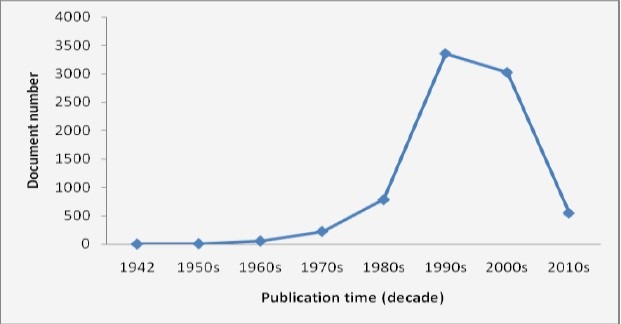
Decade publication output (total publications: 8 004). The 2010s only included documents in 2010 and 2011.
Research on GM1 could been found in the SCI-E from 1942, it was developed in the 1970s, greatly increased in the 1980s, and reached a peak in the 1990s, and it slightly decreased in 2000. Research from 2010 is at the beginning, and the develop tendency remains unclear. There were only 75 articles before the 1970s, and therefore, we analyzed articles on GM1 studies in the 1970s, 1980s, 1990s, 2000s and 2010s (only 2010 and 2011 were included).
Number of author outputs from 1970 to 2011 (Figure 2)
Figure 2.
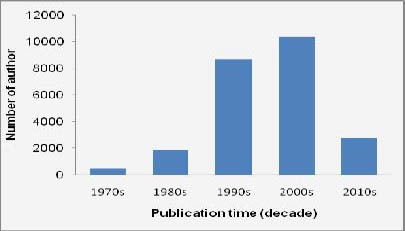
Distribution of author output in each decade from 1970 to 2011. The 2010s only included documents in 2010 and 2011.
In the 1970s, there were 472 authors of 225 documents, with 2.1 authors per article. In the 1980s, there were 1 855 authors of 784 documents, with 2.4 authors per article. In the 1990s, there were 8 651 authors of 3 355 documents, with 2.6 authors per article. In the 2000s, there were 10 401 authors of 3 023 articles, with three authors per article. In the 2010s, there were 2 741 authors of 548 articles, with five authors per article. The number of authors per article has increased in the past decades. The top two productive authors in the 1970s were R Brady and PH Fishman, with 19 and 17 articles, respectively. In the 1980s, the top two productive authors were Tettamanti G and Sonnino S, with 35 and 29 articles, respectively. In the 1990s, the top two productive authors were Kiso M with 88 articles and Hasegawa A with 79 articles, and this amount was greater than that in the 1980s. In the 2000s, although the most productive author, Yuki N published 80 articles, the second most productive author, Koga M, only published 48 articles.
Distribution of output in subject categories
Based on the classification of subject categories in Journal Citation Reports 2010, the article output data was grouped into 250 SCI subject categories. The articles of the top 13 productive subject categories in each decade were analyzed and are shown in Table 1.
Table 1.
Top 13 productive subject categories in each decade
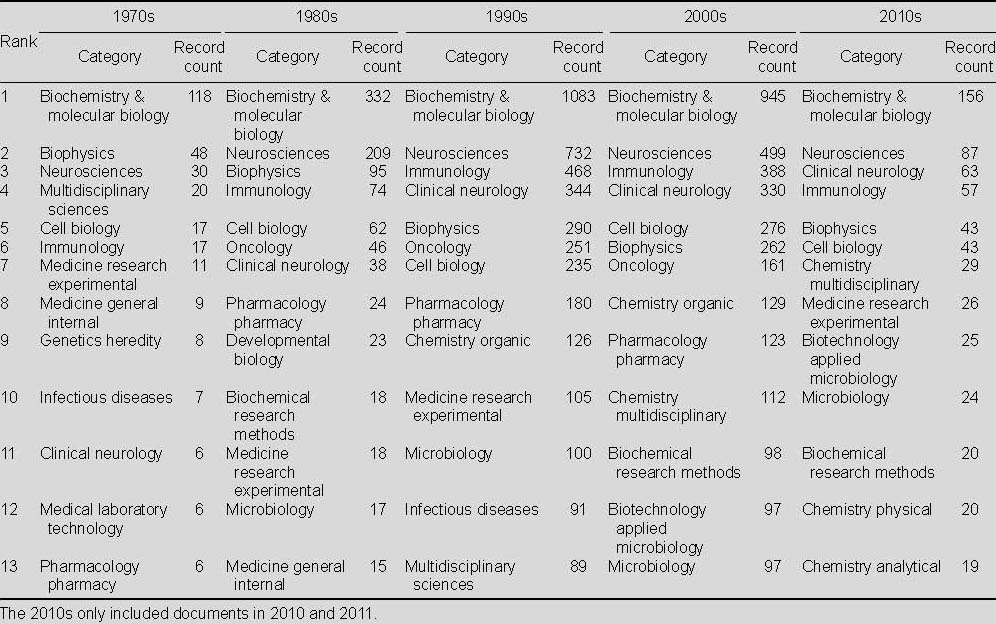
We found that the number of scientific articles per category exhibited constant growth during this period, which indicated that GM1 research has been developing steadily in various categories.
Figure 3 shows the publication output in subject categories that could be found in each decade, including biochemistry and molecular biology, biochemistry & molecular biology, biophysics, neurosciences, clinical neurology and cell biology.
Figure 3.
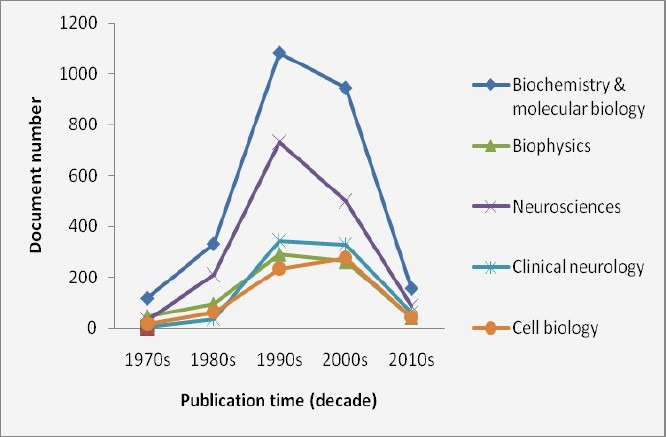
Decade publication output in the top six subject categories in 15 selected categories. The 2010s only included documents in 2010 and 2011.
The number of publications in each subject category increased in the 1980s, reached a peak in the 1990s, and slightly decreased in the 2000s. The number of publications in biochemistry and molecular biology and neuroscience ranked as the top two subject categories in previous decades. The number of publications in clinical neurology was increased from the 1980s, indicating that GM1 has attracted more attention to clinical physicians.
Publication distribution of countries
The contribution of different countries on publications was based on journal articles in which the address and affiliation of at least one author were provided. The top 10 countries in each decade are shown in Table 2.
Table 2.
The top 10 countries in each decade

We found eight countries that published articles in each decade from the beginning of GM1 research. The amount of publications in these eight countries in each decade is shown in Figure 4.
Figure 4.

Publication number of eight countries in each decade. The 2010s only included documents in 2010 and 2011.
The USA, Japan, and Germany were the three most productive countries, and the USA had the most publication numbers for all decades.
Distribution of output in journals
According to Bradford's law, the core scientific journals on a particular subject publish 33% of all documents on the subject[19]. The core subject journals in each decade are listed in Tables 3–5.
Table 3.
Core subject journals in the 1970s and 1980s

Table 5.
The top 10 journals in the 2010s

Table 4.
The core subject journals in the 1990s and 2000s

In the 1970s, there were 79 papers in seven core subject journals, which equates to 35.11% of all documents.
In the 1980s, there were 265 papers in nine core subject journals, which equates to 33.80%.
Between the 1970s and 1980s, the Journal of Biological Chemistry, Journal of Neurochemistry, Biochemical and Biophysical Research Communications, Biochemistry, Journal of Neurochemistry, Journal of Biological Chemistry, Biochimica ET Biophysica Acta, and Biochemical and Biophysical Research Communications remained the core subject journals.
In the 1990s, there were 1 098 papers in 21 core subject journals, which equates to 32.73% of all documents.
In the 2000s, there were 1 005 papers in 25 core subject journals, which equates to 33.24%.
Between the 1990s and 2000s, there were 15 core subject journals, including the Journal of Biological Chemistry, Journal of Immunology, Journal of Neuroimmunology, Glycobiology, Glycoconjugate Journal, Infection and Immunity, Carbohydrate Research, Journal of Neurochemistry, Neurology, Biochemistry, FEBS Letters, Journal of the Neurological Sciences, Brain Research, and Journal of Neuroscience Research.
Distribution of citations of each decade
According to bibliometric “law”, the main index for evaluating the quality of an article is the amount of citations it garners. Scientometrics has shown that references are considered as “classical references” once an article is cited four or more times[20]. In our analysis, the top five citations in each decade are listed in Tables 6, 7; therefore, they are classical references in the GM1 field.
Table 6.
Top five citations in the 1970s to 2000s
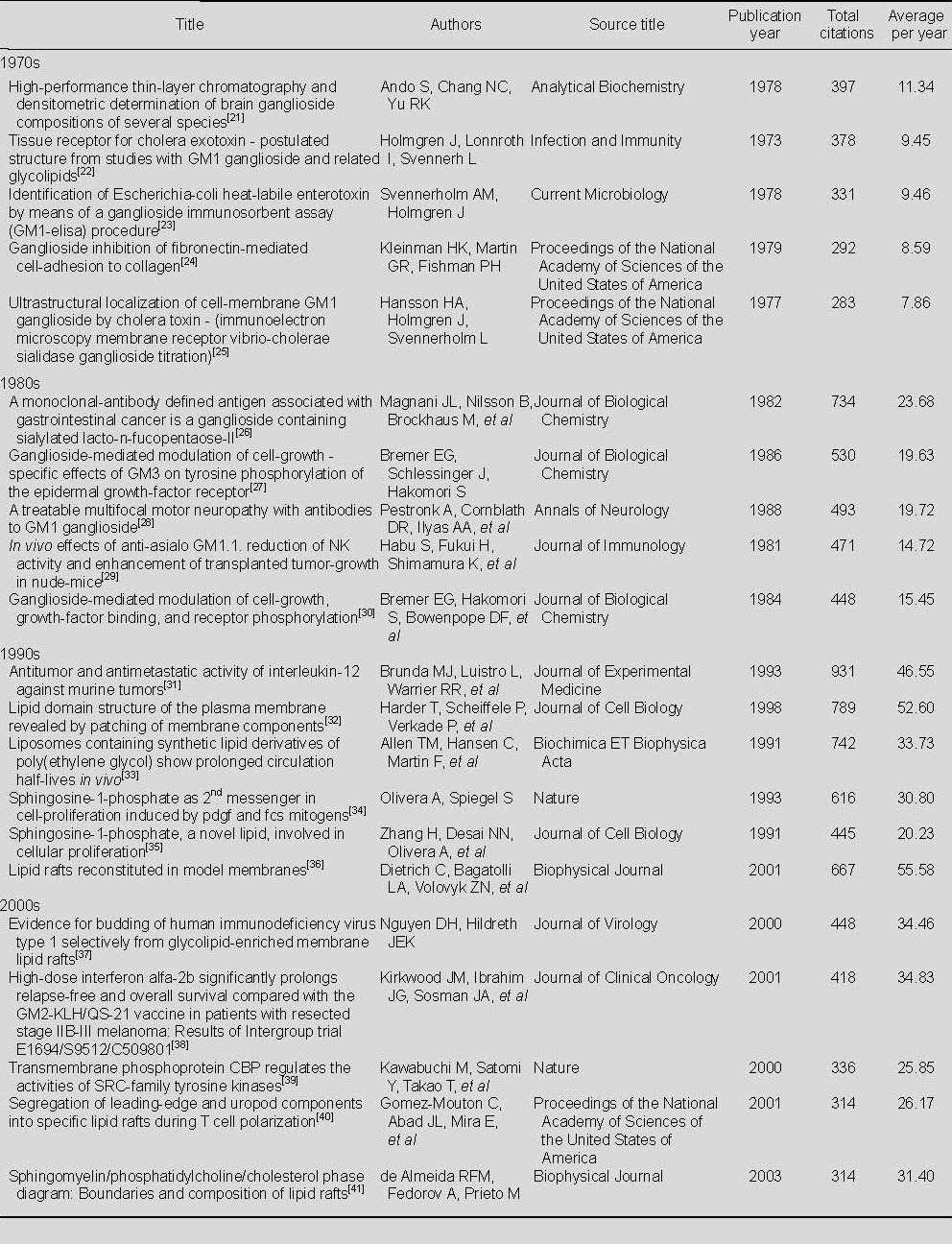
Table 7.
Top five citations in 2010s
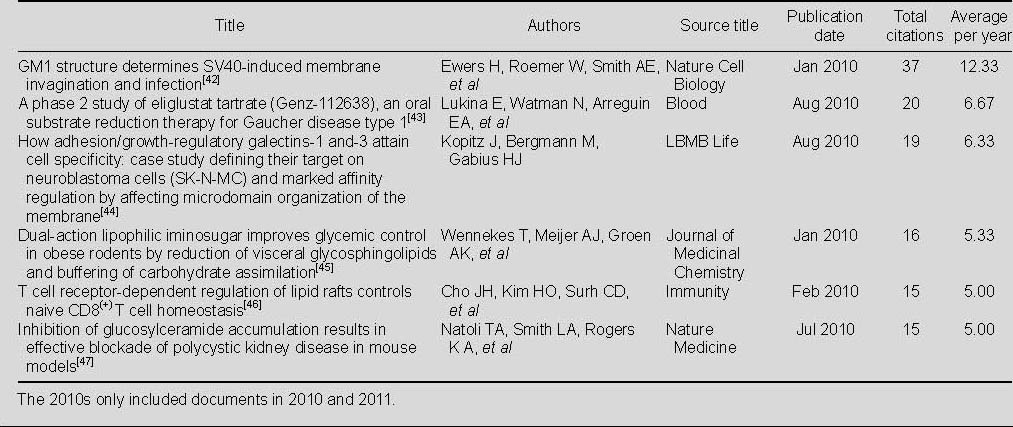
DISCUSSION
Bibliometrics is a set of methods used to study or measure texts and information[48]. Based on our bibliometric results, we showed the following research trends in the GM1 field. First, the number of publications in the GM1 field has increased since 1970. Therefore, brain glioma research has been gaining increasing attention for global scholars. Second, subject categories, including biochemistry & molecular biology, biochemistry molecular biology, biophysics, neurosciences, clinical neurology and cell biology are involved in the GM1 field. Because of this broad range, scholars and surgeons in these subjects work hard and readily publish articles on GM1. Lastly, the USA has the highest total number of publications and citations.
The Journal of Biological Chemistry, Journal of Neurochemistry and Biochemistry were core subject journals in GM1 studies in each decade.
In conclusion, scientists in the USA are the most productive GM1 researchers. In the past 50 years, China's GM1 research has ranked as nine with 99 articles in the 2000s and it was number five with 34 articles in the 2010s. However, the number of publications was still smaller than other countries including the USA, Japan, Germany and Italy. The findings of this study may be of interest for medical staff who are currently undertaking studies and for those who will be researching and studying GM1.
Footnotes
Conflicts of interest: None declared.
(Edited by Zhao LJ/Wang L)
REFERENCES
- [1].Klenk E. Z Phys Chem. 1935;235:24. [Google Scholar]
- [2].Klenk E. Z Phys Chem. 1939;262:128. [Google Scholar]
- [3].Klenk E. Ber Dt Chem Ges. 1942;75:1632. [Google Scholar]
- [4].Yamakawa T, Suzuki S. The chemistry of the lipids of posthemolytic residue or stroma of erythrocytes. I. Concerning the ether-insoluble lipids of lyophilized horse blood stroma. J Biochem. 1951;38:199–212. [Google Scholar]
- [5].Yamakawa T. Studies on erythrocyte glycolipids. Proc Jpn Acad Ser B. 2005;81:52–63. [Google Scholar]
- [6].Svennerholm L. Composition of gangliosides from human brain. Nature. 1956;177(4507):524–525. doi: 10.1038/177524b0. [DOI] [PubMed] [Google Scholar]
- [7].Takebayashi M, Hayashi T, Su TP. Sigma-1 receptors potentiate epidermal growth factor signaling towards neuritogenesis in PC12 cells: potential relation to lipid raft reconstitution. Synapse. 2004;53(2):90–103. doi: 10.1002/syn.20041. [DOI] [PubMed] [Google Scholar]
- [8].Garofalo L, Ribeiro-da-Silva A, Cuello AC. Nerve growth factor-induced synaptogenesis and hypertrophy of cortical cholinergic terminals. Proc Natl Acad Sci U S A. 1992;89(7):2639–2643. doi: 10.1073/pnas.89.7.2639. [DOI] [PMC free article] [PubMed] [Google Scholar]
- [9].Bassi S, Albizzati MG, Sbacchi M, et al. Double-blind evaluation of monosialoganglioside (GM1) therapy in stroke. J Neurosci Res. 1984;12(2-3):493–498. doi: 10.1002/jnr.490120232. [DOI] [PubMed] [Google Scholar]
- [10].Cotman CW, Nieto-Sampedro M, Harris EW. Synapse replacement in the nervous system of adult vertebrates. Physiol Rev. 1981;61(3):684–784. doi: 10.1152/physrev.1981.61.3.684. [DOI] [PubMed] [Google Scholar]
- [11].Gorio A, Carmignoto G, Facci L, et al. Motor nerve sprouting induced by ganglioside treatment. Possible implications for gangliosides on neuronal growth. Brain Res. 1980;197:236–241. doi: 10.1016/0006-8993(80)90451-5. [DOI] [PubMed] [Google Scholar]
- [12].Kwak DH, Seo BB, Chang KT, et al. Roles of gangliosides in mouse embryogenesis and embryonic stem cell differentiation. Exp Mol Med. 2011;43(7):379–388. doi: 10.3858/emm.2011.43.7.048. [DOI] [PMC free article] [PubMed] [Google Scholar]
- [13].Lee SH, Ryu JS, Lee JW, et al. Comparison of ganglioside expression between human adipose- and dental pulp-derived stem cell differentiation into osteoblasts. Arch Pharm Res. 2010;33(4):585–591. doi: 10.1007/s12272-010-0413-0. [DOI] [PubMed] [Google Scholar]
- [14].Yoshikawa M, Go S, Takasaki K, et al. Mice lacking ganglioside GM3 synthase exhibit complete hearing loss due to selective degeneration of the organ of Corti. Proc Natl Acad Sci U S A. 2009;106(23):9483–9488. doi: 10.1073/pnas.0903279106. [DOI] [PMC free article] [PubMed] [Google Scholar]
- [15].Jonsson G, Gorio A, Hallman H, et al. Effect of GM1 ganglioside on neonatally neurotoxin induced degeneration of serotonin neurons in the rat brain. Res Rep. 1984;16(2):171–180. doi: 10.1016/0165-3806(84)90023-3. [DOI] [PubMed] [Google Scholar]
- [16].Karpiaka SE. Ganglioside treatment improves recovery of alternation behavior after unilateral entorhinal cortex lesion. Exp Neurol. 1983;81(2):330–339. doi: 10.1016/0014-4886(83)90267-4. [DOI] [PubMed] [Google Scholar]
- [17].Malicdan MC, Noguchi S, Nonaka I, et al. A Gne knockout mouse expressing human GNE D176V mutation develops features similar to distal myopathy with rimmed vacuoles or hereditary inclusion body myopathy. Hum Mol Genet. 2007;16(22):2669–2682. doi: 10.1093/hmg/ddm220. [DOI] [PubMed] [Google Scholar]
- [18].Smith RE, Jr, Jaiyesimi IA, Meza LA, et al. Novel erythropoiesis stimulating protein (NESP) for the treatment of anaemia of chronic disease associated with cancer. Br J Cancer. 2001;84(Suppl 1):24–30. doi: 10.1054/bjoc.2001.1749. [DOI] [PMC free article] [PubMed] [Google Scholar]
- [19].Li T, Ho YS, Li CY. Bibliometric analysis on global Parkinson's disease research trends during 1991-2006. Neurosci Lett. 2008;441(3):248–252. doi: 10.1016/j.neulet.2008.06.044. [DOI] [PubMed] [Google Scholar]
- [20].Zhou JY, Sun T. A Quantitative analysis of digital library research article based on the Web of Science? Qingbao Kexue. 2005;23(10):1521–1525. [Google Scholar]
- [21].Ando S, Chang NC, Yu RK. High-performance thin-layer chromatography and densitometric determination of brain ganglioside compositions of several species. Anal Biochem. 1978;89(2):437–450. doi: 10.1016/0003-2697(78)90373-1. [DOI] [PubMed] [Google Scholar]
- [22].Holmgren J, Lönnroth I, Svennerholm L. Tissue receptor for cholera exotoxin: postulated structure from studies with GM1 ganglioside and related glycolipids. Infect Immun. 1973;8(2):208–214. doi: 10.1128/iai.8.2.208-214.1973. [DOI] [PMC free article] [PubMed] [Google Scholar]
- [23].Czerkinsky CC, Svennerholm AM. Ganglioside GM1 enzyme-linked immunospot assay for simple identification of heat-labile enterotoxin-producing Escherichia coli. J Clin Microbiol. 1983;17(6):965–969. doi: 10.1128/jcm.17.6.965-969.1983. [DOI] [PMC free article] [PubMed] [Google Scholar]
- [24].Kleinman HK, Martin GR, Fishman PH. Ganglioside inhibition of fibronectin-mediated cell adhesion to collagen. Proc Natl Acad Sci U S A. 1979;76(7):3367–3371. doi: 10.1073/pnas.76.7.3367. [DOI] [PMC free article] [PubMed] [Google Scholar]
- [25].Hansson HA, Holmgren J, Svennerholm L. Ultrastructural localization of cell membrane GM1 ganglioside by cholera toxin. Proc Natl Acad Sci U S A. 1977;74(9):3782–3786. doi: 10.1073/pnas.74.9.3782. [DOI] [PMC free article] [PubMed] [Google Scholar]
- [26].Magnani JL, Nilsson B, Brockhaus M, et al. A monoclonal antibody-defined antigen associated with gastrointestinal cancer is a ganglioside containing sialylated lacto-N-fucopentaose II. J Biol Chem. 1982;257(23):14365–14369. [PubMed] [Google Scholar]
- [27].Bremer EG, Schlessinger J, Hakomori S. Ganglioside-mediated modulation of cell growth. Specific effects of GM3 on tyrosine phosphorylation of the epidermal growth factor receptor. J Biol Chem. 1986;261(5):2434–2340. [PubMed] [Google Scholar]
- [28].Pestronk A, Cornblath DR, Ilyas AA, et al. A treatable multifocal motor neuropathy with antibodies to GM1 ganglioside. Ann Neurol. 1988;24(1):73–78. doi: 10.1002/ana.410240113. [DOI] [PubMed] [Google Scholar]
- [29].Habu S, Fukui H, Shimamura K, et al. In vivo effects of anti-asialo GM1. I. Reduction of NK activity and enhancement of transplanted tumor growth in nude mice. J Immunol. 1981;127(1):34–38. [PubMed] [Google Scholar]
- [30].Bremer EG, Hakomori S, Bowen-Pope DF, et al. Ganglioside- mediated modulation of cell growth, growth factor binding, and receptor phosphorylation. J Biol Chem. 1984;259(11):6818–6825. [PubMed] [Google Scholar]
- [31].Brunda MJ, Luistro L, Warrier RR, et al. Antitumor and antimetastatic activity of interleukin 12 against murine tumors. J Exp Med. 1993;178(4):1223–1230. doi: 10.1084/jem.178.4.1223. [DOI] [PMC free article] [PubMed] [Google Scholar]
- [32].Harder T, Scheiffele P, Verkade P, et al. Lipid domain structure of the plasma membrane revealed by patching of membrane components. J Cell Biol. 1998;141(4):929–942. doi: 10.1083/jcb.141.4.929. [DOI] [PMC free article] [PubMed] [Google Scholar]
- [33].Allen TM, Hansen C, Martin F, et al. Liposomes containing synthetic lipid derivatives of poly(ethylene glycol) show prolonged circulation half-lives in vivo. Biochim Biophys Acta. 1991;1066(1):29–36. doi: 10.1016/0005-2736(91)90246-5. [DOI] [PubMed] [Google Scholar]
- [34].Olivera A, Spiegel S. Sphingosine-1-phosphate as second messenger in cell proliferation induced by PDGF and FCS mitogens. Nature. 1993;365(6446):557–560. doi: 10.1038/365557a0. [DOI] [PubMed] [Google Scholar]
- [35].Zhang H, Desai NN, Olivera A, et al. Sphingosine-1-phosphate, a novel lipid, involved in cellular proliferation. J Cell Biol. 1991;114(1):155–167. doi: 10.1083/jcb.114.1.155. [DOI] [PMC free article] [PubMed] [Google Scholar]
- [36].Dietrich C, Bagatolli LA, Volovyk ZN, et al. Lipid rafts reconstituted in model membranes. Biophys J. 2001;80(3):1417–1428. doi: 10.1016/S0006-3495(01)76114-0. [DOI] [PMC free article] [PubMed] [Google Scholar]
- [37].Nguyen DH, Hildreth JE. Evidence for budding of human immunodeficiency virus type 1 selectively from glycolipid-enriched membrane lipid rafts. J Virol. 2000;74(7):3264–3272. doi: 10.1128/jvi.74.7.3264-3272.2000. [DOI] [PMC free article] [PubMed] [Google Scholar]
- [38].Kirkwood JM, Ibrahim JG, Sosman JA, et al. High-dose interferon alfa-2b significantly prolongs relapse-free and overall survival compared with the GM2-KLH/QS-21 vaccine in patients with resected stage IIB-III melanoma: results of intergroup trial E1694/S9512/C509801. J Clin Oncol. 2001;19(9):2370–2380. doi: 10.1200/JCO.2001.19.9.2370. [DOI] [PubMed] [Google Scholar]
- [39].Kawabuchi M, Satomi Y, Takao T, et al. Transmembrane phosphoprotein Cbp regulates the activities of Src-family tyrosine kinases. Nature. 2000;404(6781):999–1003. doi: 10.1038/35010121. [DOI] [PubMed] [Google Scholar]
- [40].Gómez-Móuton C, Abad JL, Mira E, et al. Segregation of leading-edge and uropod components into specific lipid rafts during T cell polarization. Proc Natl Acad Sci U S A. 2001;98(17):9642–9647. doi: 10.1073/pnas.171160298. [DOI] [PMC free article] [PubMed] [Google Scholar]
- [41].de Almeida RF, Fedorov A, Prieto M. Sphingomyelin/ phosphatidylcholine/cholesterol phase diagram: boundaries and composition of lipid rafts. Biophys J. 2003;85(4):2406–2416. doi: 10.1016/s0006-3495(03)74664-5. [DOI] [PMC free article] [PubMed] [Google Scholar]
- [42].Ewers H, Römer W, Smith AE, et al. GM1 structure determines SV40-induced membrane invagination and infection. Nat Cell Biol. 2010;12(1):11. doi: 10.1038/ncb1999. [DOI] [PubMed] [Google Scholar]
- [43].Lukina E, Watman N, Arreguin EA, et al. A phase 2 study of eliglustat tartrate (Genz-112638), an oral substrate reduction therapy for Gaucher disease type 1. Blood. 2010;116(6):893–899. doi: 10.1182/blood-2010-03-273151. [DOI] [PMC free article] [PubMed] [Google Scholar]
- [44].Kopitz J, Bergmann M, Gabius HJ. How adhesion/growth- regulatory galectins-1 and -3 attain cell specificity: case study defining their target on neuroblastoma cells (SK-N-MC) and marked affinity regulation by affecting microdomain organization of the membrane. IUBMB Life. 2010;62(8):624–628. doi: 10.1002/iub.358. [DOI] [PubMed] [Google Scholar]
- [45].Wennekes T, Meijer AJ, Groen AK, et al. Dual-action lipophilic iminosugar improves glycemic control in obese rodents by reduction of visceral glycosphingolipids and buffering of carbohydrate assimilation. J Med Chem. 2010;53(2):689–698. doi: 10.1021/jm901281m. [DOI] [PubMed] [Google Scholar]
- [46].Cho JH, Kim HO, Surh CD, et al. T cell receptor-dependent regulation of lipid rafts controls naive CD8+ T cell homeostasis. Immunity. 2010;32(2):214–226. doi: 10.1016/j.immuni.2009.11.014. [DOI] [PMC free article] [PubMed] [Google Scholar]
- [47].Natoli TA, Smith LA, Rogers KA, et al. Inhibition of glucosylceramide accumulation results in effective blockade of polycystic kidney disease in mouse models. Nat Med. 2010;16(7):788–792. doi: 10.1038/nm.2171. [DOI] [PMC free article] [PubMed] [Google Scholar]
- [48].Qiu JP, Wang HX. The level analysis of bibliometrics development in the 20th century. Gaoxiao Tushuguan Gongzuo. 2000;20(80):130. [Google Scholar]


